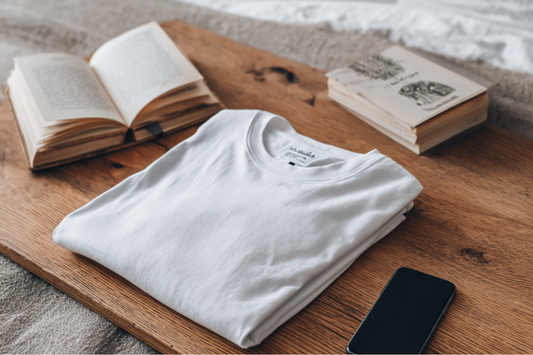
Screen Printing vs. Digital Printing: Pros and Cons
Choosing the right printing method can make or break your T-shirt business. The decision between screen printing and digital printing affects everything from your profit margins to customer satisfaction, production speed to design flexibility. While both methods can produce stunning results, understanding their unique advantages and limitations is crucial for making the right choice for your brand.
Whether you're launching a new apparel line, fulfilling corporate orders, or expanding your existing business, this comprehensive comparison will help you navigate the screen printing vs. digital printing debate with confidence.
Understanding Screen Printing: The Traditional Powerhouse
Screen printing, also known as silk screening, is a time-tested method that pushes ink through a mesh stencil onto fabric. Each color in your design requires a separate screen, making it ideal for simple designs with solid colors.
How Screen Printing Works
The process involves creating a stencil (screen) for each color in your design. Ink is then pushed through the mesh onto the T-shirt using a squeegee. The screens can be reused for identical designs, making it highly efficient for large orders.
Screen Printing Advantages
Cost-Effective for Large Orders: Once screens are created, the per-unit cost drops significantly with higher quantities. Orders of 50+ pieces typically see substantial savings.
Vibrant, Opaque Colors: Screen printing inks sit on top of the fabric, creating bold, vibrant colors that pop, especially on dark garments.
Exceptional Durability: Properly cured screen prints can withstand hundreds of wash cycles without cracking or fading.
Specialty Inks Available: Metallic, glow-in-the-dark, puff, and discharge inks offer unique effects impossible with digital printing.
Pantone Color Matching: Exact color reproduction for brand consistency across all printed materials.
Screen Printing Disadvantages
High Setup Costs: Creating screens for each color involves significant upfront investment, making small orders expensive.
Color Limitations: Each additional color increases costs and complexity. Most cost-effective designs use 1-4 colors.
Detail Restrictions: Fine details, gradients, and photographic images are challenging to reproduce accurately.
Longer Setup Time: Screen creation and press setup can take several hours before production begins.
Minimum Order Requirements: Most screen printers require minimum orders of 24-50 pieces to be cost-effective.
Digital Printing: The Modern Solution
Digital printing, including Direct-to-Garment (DTG) and heat transfer methods, uses inkjet technology to print designs directly onto fabric. This method has revolutionized small-batch and custom printing.
Digital Printing Technologies
Direct-to-Garment (DTG): Specialized inkjet printers spray water-based inks directly into fabric fibers.
Heat Transfer: Designs are printed on transfer paper or vinyl and then heat-pressed onto garments.
Sublimation: Dye is transferred from paper to polyester fabrics using heat and pressure.
Digital Printing Advantages
No Setup Costs: Each print is identical in cost whether it's the first or thousandth piece.
Unlimited Colors: Full-color designs, gradients, and photographic prints are easily achievable.
Fine Detail Reproduction: Intricate designs, small text, and complex artwork print beautifully.
Quick Turnaround: From design to finished product in hours, not days.
Small Order Friendly: Perfect for one-off customs, samples, or testing new designs.
Eco-Friendly Options: Water-based DTG inks are more environmentally friendly than plastisol screen printing inks.
Digital Printing Disadvantages
Higher Per-Unit Costs: Cost per piece remains constant regardless of quantity, making large orders expensive.
Durability Concerns: Digital prints may fade or crack sooner than screen prints, especially with frequent washing.
Fabric Limitations: Works best on 100% cotton or cotton blends; synthetic fabrics may not hold ink well.
Color Vibrancy on Dark Garments: Digital prints can appear muted on dark fabrics without proper pretreatment.
Slower Production: Each piece must be printed individually, limiting production speed for large orders.
Head-to-Head Comparison
Cost Analysis
|
Order Size |
Screen Printing |
Digital Printing |
Winner |
|
1-24 pieces |
₹180–₹300 per piece |
₹250–₹450 per piece |
Digital |
|
25-99 pieces |
₹100–₹180 per piece |
₹230–₹400 per piece |
Screen |
|
100+ pieces |
₹70–₹130 per piece |
₹220–₹380 per piece |
Screen |
|
500+ pieces |
₹40–₹90 per piece |
₹200–₹350 per piece |
Screen |
Quality Comparison
Durability: Screen printing wins for longevity and wash resistance.
Color Vibrancy: Screen printing excels on dark garments; digital printing better for full-color designs.
Detail Level: Digital printing superior for complex, detailed artwork.
Professional Appearance: Both can achieve professional results when done correctly.
Production Speed
Screen Printing: Slower setup, faster production once running. Ideal for large orders.
Digital Printing: Immediate start, consistent pace throughout. Better for rush orders and small quantities.
Choosing the Right Method for Your Business
When to Choose Screen Printing
Large Orders (50+ pieces): Cost advantages become significant with higher quantities.
Simple Designs: 1-4 solid colors work best and keep costs reasonable.
Brand Consistency: When exact color matching is crucial for brand identity.
High-Wear Items: Athletic wear, work uniforms, or frequently washed garments.
Specialty Effects: When you need metallic, glow-in-the-dark, or textured inks.
When to Choose Digital Printing
Small Orders (1-50 pieces): No setup costs make small runs economical.
Complex Designs: Full-color artwork, photographs, or intricate details.
Quick Turnaround: Rush orders or just-in-time production needs.
Testing New Designs: Sampling designs before committing to large screen printing runs.
Personalization: Custom names, numbers, or individual design variations.
Hybrid Approach: Using Both Methods
Many successful T-shirt businesses use both printing methods strategically:
Product Testing: Use digital printing to test new designs, then switch to screen printing for proven sellers.
Order Fulfillment: Screen print popular items in bulk, use digital for special requests or restocks.
Price Tiering: Offer premium digital prints for custom orders and standard screen prints for regular inventory.
Seasonal Strategy: Digital print for limited seasonal designs, screen print for year-round staples.
Quality Control Considerations
Screen Printing Quality Factors
- Ink Curing: Proper temperature and time prevent premature wear
- Screen Tension: Affects print sharpness and consistency
- Squeegee Technique: Impacts ink deposit and print quality
- Registration: Critical for multi-color designs
Digital Printing Quality Factors
- Pretreatment: Essential for dark garments and color vibrancy
- Ink Quality: Premium inks improve durability and appearance
- Printer Maintenance: Regular cleaning prevents quality issues
- Curing Process: Proper heat setting ensures wash resistance
Cost Optimization Strategies
Screen Printing Cost Reduction
- Design Simplification: Fewer colors reduce setup costs
- Order Consolidation: Combine different designs in single print runs
- Standard Colors: Using common ink colors reduces mixing costs
- Efficient Layouts: Maximize prints per screen setup
Digital Printing Cost Management
- Volume Negotiations: Some digital printers offer quantity discounts
- Design Optimization: Reduce ink coverage where possible
- Fabric Selection: Choose compatible fabrics for better results
- Batch Processing: Group similar orders for efficiency
Future Trends and Technology
Screen Printing Innovations
- Eco-Friendly Inks: Water-based and discharge inks gaining popularity
- Automated Systems: Reducing labor costs and improving consistency
- Hybrid Techniques: Combining screen printing with digital elements
Digital Printing Advancements
- Improved Durability: New ink formulations matching screen print longevity
- Faster Printing: Higher-speed DTG printers reducing production time
- Expanded Materials: Better compatibility with synthetic and performance fabrics
Making Your Decision
Consider these key factors when choosing your printing method:
Business Model: Are you focused on custom orders or bulk production?
Design Complexity: Simple logos or full-color artwork?
Order Volumes: Consistently large orders or variable quantities?
Turnaround Requirements: Rush orders or planned production schedules?
Quality Priorities: Maximum durability or design flexibility?
Budget Constraints: High upfront costs acceptable or need low entry barriers?
Common Mistakes to Avoid
Choosing Based on Price Alone: Consider quality, durability, and customer satisfaction.
Ignoring Fabric Compatibility: Some printing methods work better with specific fabric types.
Underestimating Setup Time: Plan for longer lead times with screen printing.
Overlooking Durability: Consider how customers will use and wash the garments.
Not Testing First: Always request samples before committing to large orders.
Final Thoughts
Both screen printing and digital printing have their place in the modern T-shirt industry. The key is understanding when to use each method to maximize quality, minimize costs, and satisfy customer expectations.
Screen printing remains the gold standard for large orders, simple designs, and maximum durability. Digital printing excels for small batches, complex artwork, and quick turnarounds. Many successful businesses use both methods strategically, leveraging each technique's strengths for different situations.
The best choice for your business depends on your specific needs, customer expectations, and growth plans. Consider starting with the method that best fits your current situation, then expand to include both techniques as your business grows.
Ready to Optimize Your T-Shirt Printing Strategy?
At Varthagam International, we help apparel brands choose the right printing methods and connect with reliable printing partners. From quality assessment to production planning, we ensure your T-shirts meet the highest standards while maximizing profitability.
Visit varthagaminternational.in or Book a Call with us or Chat with us on Whatsapp to discuss your printing needs and develop the perfect production strategy for your brand.



